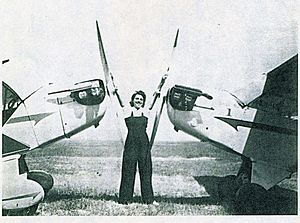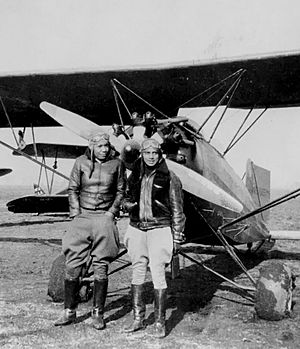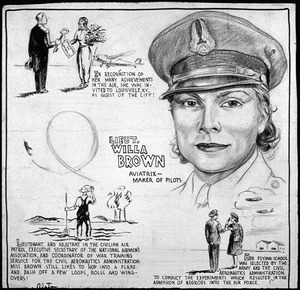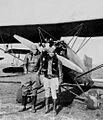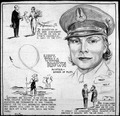Willa Brown facts for kids
Quick facts for kids
Willa Brown
|
|
|---|---|

Brown as a lieutenant in the United States Civil Air Patrol
|
|
| Born | January 22, 1906 |
| Died | July 18, 1992 (aged 86) |
| Other names | Willa Brown Chappell |
| Occupation | Pilot, lobbyist, activist, teacher |
| Known for | Civil rights leader First female African American pilot licensed in the United States First African American officer in the United States Civil Air Patrol First African American woman to run for United States Congress |
| Spouse(s) |
Wilbur Hardaway
(m. 1929; div. 1931)Rev. J. H. Chappell
(m. 1955, |
Willa Beatrice Brown (born January 22, 1906 – died July 18, 1992) was an amazing American woman. She was a pilot, a lobbyist (someone who tries to influence laws), a teacher, and a civil rights activist. She made history many times.
Willa was the first African American woman to get a pilot's license in the U.S. She was also the first African American woman to run for the United States Congress. She became the first African American officer in the Civil Air Patrol. Plus, she was the first woman in the U.S. to have both a pilot's license and an aircraft mechanic's license.
Willa worked her whole life for fairness. She wanted everyone to have equal chances in aviation (flying) and the military. She pushed the U.S. government to allow African Americans into the United States Army Air Corps. She also helped them join the Civilian Pilot Training Program (CPTP).
Willa and Cornelius Coffey started the Coffey School of Aeronautics. This was the first private flight school in the U.S. owned by African Americans. She trained hundreds of pilots there. Many of her students became Tuskegee Airmen. Her training efforts helped create this famous group of pilots.
Willa stayed active in Chicago even after her school closed in 1945. She ran for Congress in 1946 and 1950. She taught in Chicago schools until she retired in 1971. After retiring, she served on a special committee for the Federal Aviation Administration.
Contents
Early Life and Education
Willa Beatrice Brown was born on January 22, 1906. Her parents were Eric and Hallie Brown. She grew up in Glasgow, Kentucky.
She finished Wiley High School in Terre Haute, Indiana. In 1927, she earned a bachelor's degree from Indiana State Teachers College. Ten years later, she got an M.B.A. (Master of Business Administration) from Northwestern University.
From 1927 to 1932, Willa taught at Emerson High School in Gary, Indiana. Then she moved to Chicago. There, she worked as a secretary, a social worker, and a teacher. In 1934, she met John C. Robinson. He introduced her to a group of African American pilots.
Willa Brown's Aviation Career
In 1934, Willa started learning to fly. She studied at Harlem Field in Chicago. This airport was segregated, meaning Black and white people were kept separate. Her flight instructor was Cornelius Coffey. He was an expert in airplane mechanics.
Willa was one of the few women at Curtiss–Wright Aeronautical University. She studied how to fix airplanes there. In 1935, she earned her aircraft mechanic's license. She got her private pilot's license in 1938. Then, in 1939, she earned her commercial pilot's license. This made her the first African American woman in the U.S. to get both licenses.
Willa Brown, Cornelius Coffey, and Enoch P. Waters started a group. It was first called the National Negro Airmen Association of America. Later, it became the National Airmen's Association of America in 1939. Their main goal was to get more people interested in flying. They wanted to help more African Americans join aviation.
Willa was the national secretary for the group. She was also the president of its Chicago branch. She worked hard for racial equality. She also handled public relations. She flew to colleges and spoke on the radio. She wanted to get African Americans excited about flying.
She and Coffey opened the Coffey School of Aeronautics in Chicago. It was at Harlem Airport. They started the school to train Black pilots. They also taught airplane mechanics.
Willa spoke to the government. She wanted Black pilots to be part of the United States Army Air Corps. At that time, the Army Air Corps was segregated. She also pushed for Black pilots to join the federal Civilian Pilot Training Program (CPTP).
She worked to prove wrong a study from 1925. This study from the United States Army War College said African Americans were not fit to fly. Willa fought for the government to give CPTP contracts to train African American pilots.
In 1940, she became the coordinator for the CPTP units in Chicago. The U.S. Army Air Corps chose the Coffey School. It became a feeder school. This meant it sent Black students to the Army's pilot training program. Nearly 200 students from the school joined the Tuskegee Airmen.
In 1942, Willa became a Lieutenant in Civil Air Patrol Squadron 613-6. This made her the first African American officer in the Civil Air Patrol. Later, she was appointed war-training service coordinator for the Civil Aeronautics Authority.
After the War
In 1946, Willa ran in the Republican Party primary election. She was running for a seat in Congress from Illinois's 1st congressional district. She was the first African American woman to run in a primary election for Congress.
Her campaign focused on creating more chances for African Americans. She wanted an airport owned and used by African Americans. She lost the election to William E. King. She ran for the same Congressional seat again in 1950. She was defeated by Archibald Carey Jr..
Willa returned to teaching high school from 1962 until 1971. She taught business and aeronautics. From 1972 to 1975, she served on the Women's Advisory Committee of the Federal Aviation Administration. She was the first Black woman to be on that committee.
Personal Life
Willa Brown was married three times. Her first husband was Wilbur J. Hardaway. He was an African American firefighter. They met when Willa was teaching in Gary, Indiana. They married in 1929 and divorced in 1931.
Enoch P. Waters described Willa Brown:
When Willa Brown, a shapely young brownskin woman, wearing white johdpurs, a form fitting white jacket and white boots, strode into our newsroom, in 1936, she made such a stunning appearance that all the typewriters suddenly went silent...Unlike most visitors, [she] wasn't at all bewildered. She had a confident bearing and there was an undercurrent of determination in her husky voice as she announced, not asked, that she wanted to see me.
In 1947, Willa and Cornelius Coffey got married. Their marriage did not last long. Her last marriage was to Reverend J. H. Chappell in 1955. He was the pastor of the Chicago West Side Community Church. She was a widow by 1991.
Awards and Recognition
- In 1939, Willa Brown was mentioned in the 76th Congressional Record. This was for her achievements in aviation.
- Time magazine wrote about Willa Brown in its September 25, 1939 issue.
- In 2002, Women in Aviation International named Willa Brown one of the 100 most important women in aviation and space.
- In 2003, Willa Beatrice Brown was added to the Kentucky Aviation Hall of Fame. This was ten years after she passed away.
- In 2010, Willa received the Distinguished Alumni Award. This award was from the Indiana State University Alumni Association.
- A historical marker (#238) was put up in Glasgow, Kentucky. It is at the corner of Race and Washington Streets. The marker honors Willa Brown Chappell. It calls her "the first African American woman to earn a pilot's license in the United States."
Images for kids
See also
 In Spanish: Willa Brown para niños
In Spanish: Willa Brown para niños


